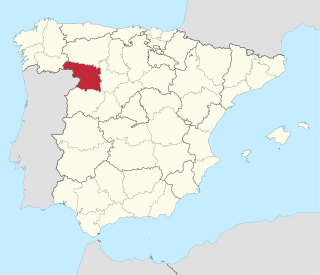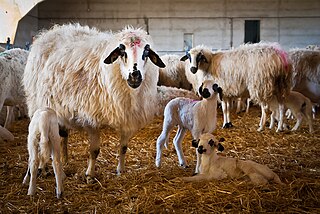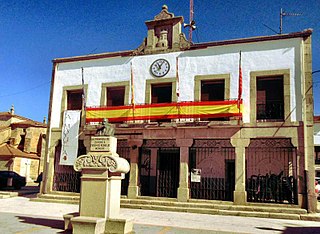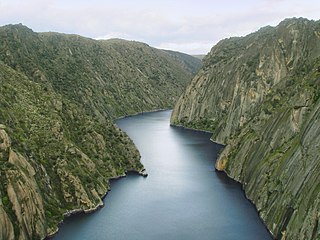
The Douro is the highest-flow river of the Iberian Peninsula. It rises near Duruelo de la Sierra in the Spanish province of Soria, meanders south briefly then flows generally west through the northern part of the Meseta Central in Castile and León into northern Portugal. Its most plentiful tributary is the right-bank Esla river. At Douro's mouth at Porto, the second largest city of Portugal, the river meets the Atlantic Ocean.

Castile and León is an autonomous community in northwestern Spain.

Salamanca is a province of western Spain, in the western part of the autonomous community of Castile and León. It is bordered by the provinces of Zamora, Valladolid, Ávila, and Cáceres, and on the west by Portugal. It has an area of 12,349 km² and in 2018 had a population of 331,473 people. It is divided into 362 municipalities, 11 comarcas, 32 mancomunidades and five judicial districts. Of the 362 municipalities, more than half are villages with fewer than 300 people.

Zamora is a province of western Spain, in the western part of the autonomous community of Castile and León. It is bordered by the provinces of Ourense, León, Valladolid, and Salamanca, and by Portugal.

The Churra is an Iberian type, breed or group of breeds of sheep. The word churra simply means 'coarse-woolled'. The Churra originates in the Duero Valley in the autonomous community of Castile and León in north-western Spain. In the province of Zamora the milk is used to make Zamorano cheese.

Mogadouro is a municipality in Portugal. The population in 2011 was 9,542, in an area of 760.65 km2.

Fermoselle is a small medieval village located in the province of Zamora, western Spain, and is part of the region of Castile and León in the south-west region of the province. It has a population of fewer than 1500.

Bermillo de Sayago is a municipality located in the province of Zamora, Castile and León, Spain. According to the 2009 census (INE), the municipality has a population of 1,259 inhabitants. It works as the territorial capital of Sayago, leading this comarca but with no official status. Its central position and the fact of a clearly higher population have given the town this role. Furthermore, the municipalities association Sayagua has its headquarters in Bermillo. This organization is a mancomunidad that supplies services like recycling or water through the comarca of Sayago that could not be afforded by the so-little towns in the area.
Luelmo is a municipality located in the province of Zamora, Castile and León, Spain; and in the territorial area of Sayago. According to the 2004 census (INE), the municipality has a population of 228 inhabitants.

Moralina is a municipality located in the province of Zamora, Castile and León, Spain. According to the 2004 census (INE), the municipality has a population of 346 inhabitants. It is 42 km (26 mi) away from the city of Zamora. The village belongs to the Sayago county or comarca, and participates in the association Sayagua, which supplies the water and the recycling system in the whole county, as the municipies are too small and weak to maintain this kind of services by themselves.

Torregamones is a municipality located in the province of Zamora, Castile and León, Spain. According to the 2007 census (INE), the municipality has a population of 310 inhabitants. It plays a relative importance in the comarca of Sayago, as a link between Portugal and this zone of the province of Zamora. Apart from Portugal, Torregamones abuts with Villardiegua de la Ribera to the north, Moralina to the east and also Gamones to the south.

Arribes del Duero Natural Park is a protected area in western Spain, covering 106.105 ha in the autonomous community of Castile and León. In this area the river Duero forms the national boundary between Spain and Portugal, and the Portuguese side is also protected under the Douro International Natural Park. The most notable characteristics of this natural space are its biodiversity and range of watercourses, which have eroded deep valleys and vertiginous precipices. This landscape is known as Arribes, which is where the reserve name comes from.

The Almendra Dam, also known as Villarino Dam, in Salamanca, Spain, interrupts the course of the River Tormes five kilometres from the village from which it takes its name: Almendra. It was constructed between 1963 and 1970.

Arribes is a Spanish Denominación de Origen Protegida (DOP) for wines located in the southeast of the province of Zamora and the northeast of the province of Salamanca, along the border with Portugal on the banks of the River Duero.

The Region of León, Leonese region or Leonese Country is a historic territory defined by the 1833 Spanish administrative organisation. The Leonese region encompassed the provinces of Salamanca, Zamora, and León, now part of the modern Spanish autonomous community of Castile and León. As is the case with other historical regions, and continuing with centuries of history, the inhabitants of the Leonese region are still called Leonese. Even today, according with official autonomous government, the historical territorial adjective is used in addition with the modern annexed territory, the rest of Old Castile, being "Castilians and Leonese".

Aliste is a comarca located in the west of the province of Zamora, Castile and León, Spain, bordering with Portugal in the west and in the south. It covers 193,883 hectares. Aliste is an area that has preserved a rich cultural and ethnological tradition through years of isolation. Aliste is perhaps the poorest zone within the province, the economy of this deeply rural comarca is based on cattle rearing. The origin of the name Aliste appears as Alesti in a 9th Century manuscript, referring to the trees (alisos) which can be seen on the banks of what is now called the Aliste River.

Arribes are the banks of the rivers in the southeast of the province of Zamora and the northeast of the province of Salamanca, Castile and León, Spain.

Tierra del Pan is a comarca located in the center of the province of Zamora, western Spain. It belongs to the Autonomous Community of Castile and León. The city of Zamora, capital of the province, is included in this comarca.

Trás-os-Montes is a geographical, historical and cultural region of Portugal.



















